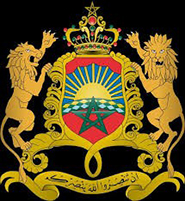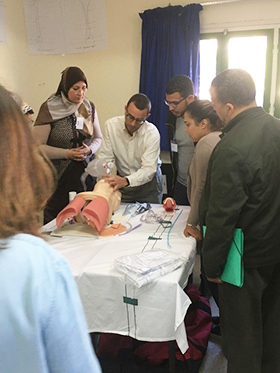Morocco Emergency Care and Life Support Program

Agadir, Morocco
HUMANITARIAN PARTNERS
Moroccan Ministry of Health
Souss Massa Draa Regional Health Department
Agadir Regional Health Management
Corporate Social Responsibility (CSR) of Chevron Morocco Exploration Limited
Timline: January - February 2017
PURPOSE:
-
- Advance Emergency Medicine in Morocco
- A 2016 Needs Assessment from the Moroccan Ministry of Health in collaboration with University of Utah Global Partners identified emergency medicine as an area of need.
Morocco Ministry of Health partners
-
- Dr. Nazih El Kouartey, National Ministry of Health, Rabat
- Senior management of the Ministry of Health, Rabat
- Dr. Abdelmoula Boulamizat, Health Regional Director of the Souss Massa Draa area within the Health Regional Department
- Regional Agadir health management team/senior leadership
Course instructors
“Train the Trainer” Emergency Medicine Team University of Utah School of Medicine:
-
- Dr Peter Taillac, Clinical Professor of Surgery/Emergency Medicine, University of Utah School of Medicine
- Dr. Vijayabhaskar Reddy Kandula , Associate Professor (Adjunct), Department of Family and Preventive Medicine
- Dr. Michael Morgan, Global Health Fellow in Emergency Medicine, University of Utah School of Medicine
- Don Pedersen PhD, PA Emeritus Professor, Department of Family and Preventive Medicine
- Steve Sugerman MPAS, PA-C, Lead Advanced Practice Clinician, Division of Emergency Medicine, University of Utah Healthcare
- Kathy Pedersen MPAS, PA-C, Associate Professor, Department of Family and Preventive Medicine
OBJECTIVES:
Upgrade clinician skills in emergency medicine to:
-
- Recognize critical illness and injury
- Provide stabilization and safe transfer
Curriculum:
-
- Recognition of Critical Injury and Illness
- Emergency Airway Management
- Emergency Trauma Management
- Emergency Burn Management
- Emergency Pediatric Management
- Neonatal Resuscitation
- Emergency Obstetric Management
- Emergency Cardiac Management
- Emergency Toxicology and Animal bites
Results:
The participant pretest yielded varying scores all of which improved on the posttest.
The average pretest scores for course 1 and 2 were 61% and 60% respectively. The average posttest scores were 77% and 87% for the same groups. In the first group were 14 physicians, 4 nurse midwives, 3 nurses, and 3 nurse anesthetists.
In the second group were 11 physicians, 8 nurses, and 2 midwives. All participants passed the practical hands on and case-based portions of the final exam.
Participant expectations identified at the onset of the course were: head injuries, toxicology, pediatric emergencies, obstetric emergencies, hemophilia, polytrauma and pre-hospital care, drowning, and intoxication. Most of these topics were already in the curriculum, and the additional topics were discussed as well. General discussion ensued during the courses on the Moroccan system for recognition of critical illness and injury, stabilization; in particular, safe transfer. The written reviews of the course by the Moroccan participants were uniformly positive.
Participant expectations identified at the onset of the course were: head injuries, toxicology, pediatric emergencies, obstetric emergencies, hemophilia, polytrauma and pre-hospital care, drowning, and intoxication. Most of these topics were already in the curriculum, and the additional topics were discussed as well. General discussion ensued during the courses on the Moroccan system for recognition of critical illness and injury, stabilization; in particular, safe transfer. The written reviews of the course by the Moroccan participants were uniformly positive.
Reference: Pedersen K. Report on the Emergency Care and Life Support Program. 2017

Steve Sugerman University of Utah Emergency Medicine PA and Moroccan team
